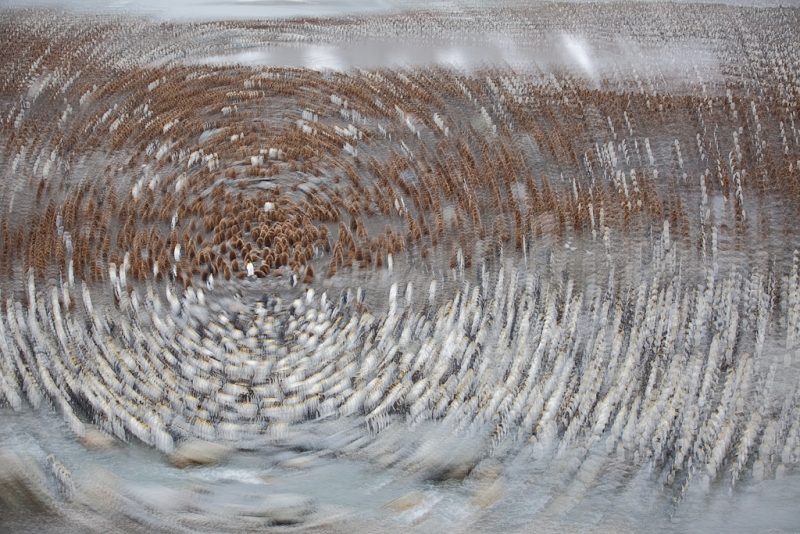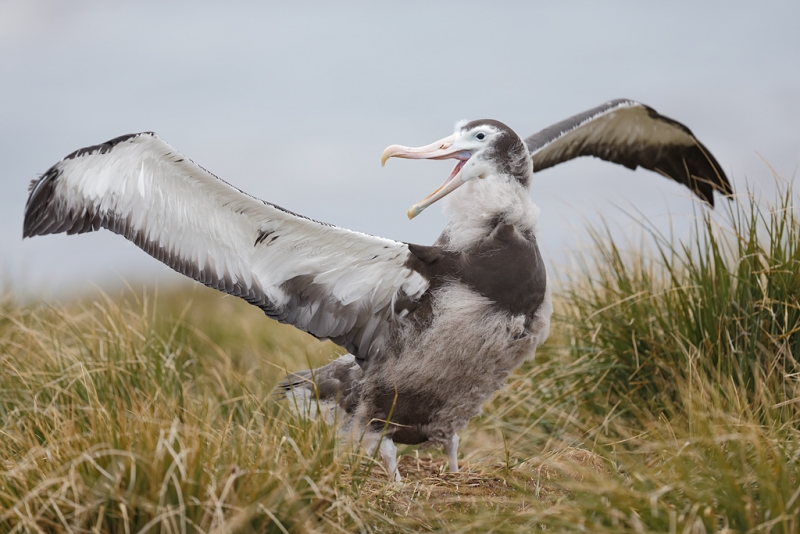Don’t Be Late: B&H (Free) Event Space Events!
|
This 5-frame in-camera multiple exposure depicting large numbers of Oakum Boys (immature King Penguins) was created at St. Andrews Bay, South Georgia with the tripod-mounted Canon EF 70-200mm f/2.8L IS II USM Telephoto Zoom Lens (at 190mm) and the Canon EOS 5D Mark III Digital Camera (Body Only) w/FREE Bonus Items – $160.75 Value! [expires 11/24]!. ISO 400. Evaluative metering at zero: 1/5000 sec. at f/2.8 in Manual mode. Central sensor/AI Servo/Rear Focus AF and re-compose. Click here if you missed the Rear Focus Tutorial. Click on the image to see the spectacular larger version. I love both the in-camera HDR and Multiple Exposure features of the EOS-5D Mark III. Learn to use them both in the 5D Mark III User’s Guide. |
Don’t Be Late: B&H (Free) Event Space Events!
B&H Event Space Events sell out quickly. Skip the promos below and register for the two great events below by clicking on the following links:
If one or both events is full, be sure to check back often. We hope to see you there.
Pleasing Blurs
On Wednesday, December 19, 2012 Denise Ippolito and I will present “Learning to Create Pleasing Blurs” from 1:00 to 3:00PM at the B&H Event Space in the NYC Superstore. They liked the program so much that they invited us back for a reprise. This event is being generously co-sponsored by Manfrotto and Canon USA.
Professional nature photographers Denise Ippolito and Arthur Morris co-authored the hugely popular eBook, “A Guide to Pleasing Blurs”. Their program will cover the great variety of techniques that can be used to create pleasingly blurred images, mostly in-camera in the field, and at times, during post-processing. Topics that will be discussed and illustrated include pan blurs, vertical pan blurs, zoom blurs, camera movement blurs including flame and jiggles, flash blurs, subject movement blurs including moving water blurs, long exposure blurs, the need for accurate focusing, managing your ISO settings, in-camera multiple exposures, subject to film plane orientation, the role of neutral density and polarizing filters when creating pleasing blurs, choice of shutter speeds, and how subject to sensor distance affects the degree of blurring.
With the advent of digital photography and the popularity of intentionally blurred images in prestigious nature photography competitions, more and more people are enjoying the challenges and rewards of creating pleasing blurs. Whether you photograph wildlife, flowers, people, street scenes, or landscapes, this is one program that you will not want to miss if you would like to unleash your creativity. Join Denise (www.deniseippolito.com) and Arthur (www.BIRDSASART-blog.com) for two hours of fun and learning.
|
This image of a young Wandering Albatross was created at Prion Island, South Georgia with the hand held Canon EF 300mm f/2.8L IS II USM Telephoto Lensand the Canon EOS-1D X Digital SLR Camera (Body Only). ISO 400. Evaluative metering +1/3 stop: 1/1000 sec. at f/2.8 in Manual mode. Central sensor/AI Servo Surround/Rear Focus AF and re-compose. Click here if you missed the Rear Focus Tutorial. Click on the image to see a larger version. As you are limited to a narrow boardwalk and a small platform I needed to un-mount my 1.4X III TC and get it into the pocket of my parka. I did. Learn how I smashed both my 1DX and my new 50mm f/4L IS II lens here. |
Choosing & Using Lenses
On Wednesday, December 19, 2012 I will present “Lenses for Bird and Nature Photography/BIRDS AS ART Style from 4:00 to 6:00PM at the B&H Event Space in the NYC Superstore. This event is being generously sponsored by Canon USA.
In this practical and educational slide program we will learn which Canon lenses—from the 8-15mm fish eye up to the 800mm f/5.6 L IS, that Artie uses to create his amazing images, how, why, and when he uses each of them, and what he is thinking as he depresses the shutter button. Most folks will be surprised to learn that a long lens with a teleconverter is often not the best tool for the job. In addition Artie will comment on exposure and image design.
EOS-5D Mark III User’s Guide
With the wreck of my EOS-1D X (see “Wrecked. And Loving It” for complete details), I went to my 5D Mark III as my workhorse camera body. It performed flawlessly surviving some heavy drizzle, sand, grit, and extensive use. I used it almost exclusively for seabird flight photography from the ship. As I have said from the get-go, the 5D Mark III’s new AF system is superb.
You can learn everything about it including my custom case for flight photography, my favorite AF Area Selection Modes, how I use the great HDR and Multiple Exposure Features, and pretty much everything that I know about this great lightweight camera here. I will be updating the guide in January. All updates are free.
Learn more or purchase here.
To thank us for all the free info that we provide on the blog, in Bulletins, and via e-mail, or if your decision to purchase a 5D III was influenced by what you learned here, please use one of our B&H affiliate links immediately below to order and e-mail me a copy of your receipt. The upper logo-link is for the body alone (along with ($154.83 of free items), the lower link for a kit with the body and my B-roll lens, the 24-105mm zoom. (I never leave home without it.)


EOS-1D X Autofocus Guide
Learn the ins and out of this great pro bodies killer AF system including my personalized Case for flight photography here.
DPP Conversion Guide
Both of the images above and all of my Southern Oceans Expedition photographs were converted in DPP. Learn more about this new guide and why you might wish to switch to DPP here.
Shopper’s Guide
Thanks a stack to all who have used our B&H affiliate links to purchase their gear as a thank you for all the free information that we bring you on the Blog and in the Bulletins. Before you purchase anything be sure to check out the advice in our Shopper’s Guide.
Shop B&H

Support the BAA Blog. Support the BAA Bulletins. We want and need to keep providing you with the latest free information, photography and Photoshop lessons, and all manner of related information. Show your appreciation by making your purchases immediately after clicking on any of the links above. Remember, B&H ain’t just photography!
And from the BAA On-line Store:
LensCoats. I have a LensCoat on each of my big lenses to protect them from nicks and thus increase their re-sales value. All my big lens LensCoat stuff is in Realtree AP (All Purpose) Snow pattern.
LegCoat Tripod Leg Covers. I have four tripods active and each has a Hardwood Snow LegCoat on it to help prevent further damage to my tender shoulders 🙂 And you will love them in mega-cold weather….
Gizo GT3532 LS CF Tripod. This one replaces the GT3530LS Tripod and will last you a lifetime. Learn more about this great tripod here.
Mongoose M3.6 Tripod Head. Right now this is the best tripod head around for use with lenses that weigh less than 9 pounds. For heavier lenses, check out the Wimberley V2 head.
Double Bubble Level. You will find one in my camera’s hot shoe whenever I am not using flash.
The Lens Align Mark II. I use the Lens Align Mark II pretty much religiously to micro-adjust all of my gear an average of once a month and always before a major trip. Enjoy our free comprehensive tutorial here.
BreezeBrowser. I do not see how any digital photographer can exist without this program.
Delkin Flash Cards. I use and depend on Delkin compact Flash Cards and card readers most every day. Learn more about their great 700X and 1000X cards here or about my favorite Delkin card here.
















I agree Albatros is just darling…what a little clown! Makes me think of Red Skelton…
Your image of the Oakum Boys is very interesting. I realize it is an – camera multiple exposure but what did you do to create the swirl effect?
Good question Ted. Set everything up on the tripod. Made the first image with the lens rotated about 3 degrees counter-clockwise, loosened the tripod collar, rotated it about 1/12 degrees clock-wise, then level and then two more going 1 1/2 degrees clockwise. As always with blurs, I took a lot. And as often happens, the first one was the winner. Don’t ask me how I got the point of rotation offset….
Hi Artie , what a nice trip , the Albatros picture is Lovely .
A hug.